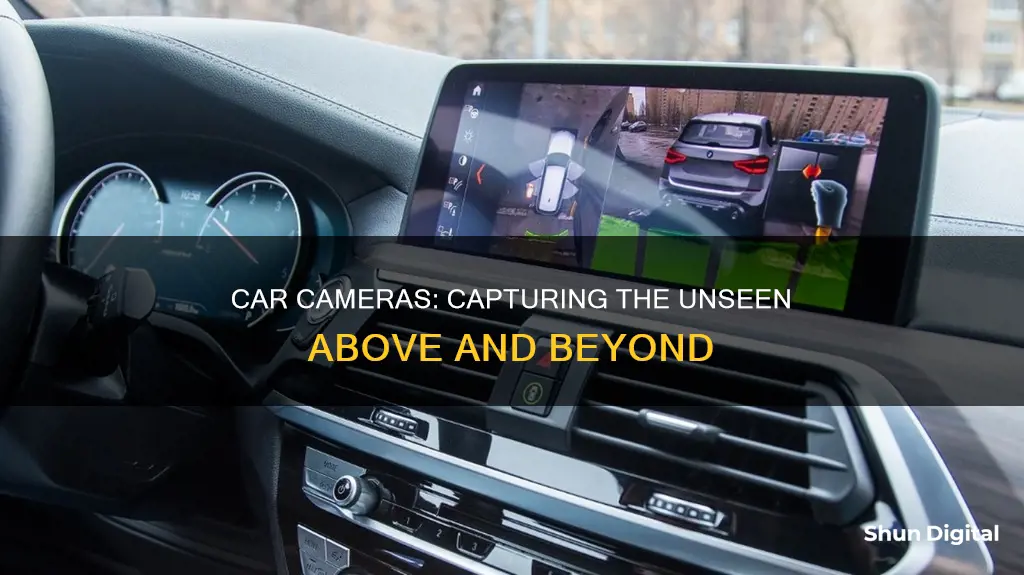
Car cameras, also known as 360-degree or bird's-eye-view cameras, provide a top-down view of the car and its surroundings, making parking and manoeuvring into tight spots much easier. This is achieved by stitching together feeds from multiple cameras positioned around the car and using image-processing software to create a composite, cohesive view. The final image, displayed on the car's infotainment screen, looks like it was captured by a drone flying above the vehicle. This technology is now offered by almost every major automaker and is particularly useful for larger vehicles and off-road driving.
| Characteristics | Values |
|---|---|
| Name | 360-degree camera, Bird's Eye View Camera, Around View Monitor, Surround View Camera |
| Purpose | To help drivers see their car and surroundings from above, aiding parking and manoeuvring |
| Function | Uses 4-6 cameras placed around the car to create a composite, bird's-eye view |
| Camera Placement | Front grille, exterior rear-view mirrors, rear of the vehicle, sides |
| Display | Split-screen view, often with the top view of the car on one side and the front/rear/side view on the other |
| Additional Features | Proximity alerts, guidelines, audio alerts |
What You'll Learn
- Car cameras use multiple cameras and image stitching to create a bird's-eye view
- The cameras are placed in the grille, under side mirrors, and near the boot latch
- Image-processing software combines individual images to create a top-down view
- The system aids in parking and manoeuvring, especially in tight spots
- It is a valuable safety feature, helping to spot pedestrians and avoid obstacles

Car cameras use multiple cameras and image stitching to create a bird's-eye view
The bird's-eye view is achieved by strategically placing cameras around the vehicle, typically including a front-facing camera, side-view cameras, and a rear-facing camera. These cameras have wide-angle lenses to capture as much information as possible about the surroundings. The video signals from these cameras are then fed into an image-processing program.
The image-processing program analyses and combines the individual camera inputs to create a synthetic but accurate top-down view. This process involves geometric alignment, photometric alignment, and composite view synthesis. The software ensures that the final image appears seamless, as if captured by a single camera from above.
The resulting bird's-eye view is displayed on the vehicle's infotainment screen, often with a split-screen feature that shows both the top-down view and the traditional rearview or backup camera perspective. This dual-image display is particularly useful when manoeuvring into tight spaces or parallel parking.
The bird's-eye view technology not only enhances safety by helping drivers spot obstacles and pedestrians but also assists in navigating into parking spots with ease. It is an impressive advancement in automotive technology that improves the driving experience and reduces the stress of parking in challenging situations.
RAW Capture: Red One Camera's Superpower
You may want to see also

The cameras are placed in the grille, under side mirrors, and near the boot latch
Car cameras, or dash cams, are an incredibly useful piece of technology that can help with parking, record footage in case of accidents, and even help the car drive. But how do they see above the car?
Well, it's all down to some clever tech. Car cameras are usually placed in the grille, under the side mirrors, and near the boot latch. These cameras have extremely wide-angle lenses to capture as much information about the surroundings as possible. The camera system then stitches together the feeds from these different cameras to provide a holistic view, or what is known as a bird's-eye view, which is displayed on the car's infotainment screen. This simulated aerial view is created by using perspective transformations (math) to stitch together the camera pixels from the different cameras.
The result is a synthetic but positionally accurate top-down view of the car and its surroundings. In most modern systems, the pictures appear in such lifelike detail that it's difficult to believe they weren't taken from above the vehicle. This 360-degree view can be incredibly helpful when parking, especially in tight spaces or when parallel parking. It can also help spot pedestrians, particularly children, when reversing or manoeuvring.
In addition to the safety benefits, car cameras can also provide peace of mind in case of accidents. By recording footage of the road and the vehicle's surroundings, dash cams can help prove your innocence in the event of a collision. They can also be used to record out of the rear windscreen, capturing footage if you are hit from behind. Some dash cams even have a button to quickly save the last few seconds of video, so you can capture important moments even if they didn't involve your vehicle directly.
Sigma Dealer Focus Camera: Certified and Trustworthy
You may want to see also

Image-processing software combines individual images to create a top-down view
The "bird's eye view" or "surround view" of a car is created by combining individual images from multiple cameras placed around the car. These cameras are typically located in the grille, under the side mirrors, and near the boot latch. The images are then stitched together by image-processing software to create a top-down view of the car and its surroundings. This software takes into account the angle, position, and field of view of each camera to create a seamless, coherent image.
The process of combining these images involves geometric alignment, photometric alignment, and composite view synthesis. Geometric alignment includes lens distortion correction and transformation of perspective, while photometric alignment matches the brightness and colour of individual camera views. The composite view synthesis is where the actual stitching of images takes place. This involves image registration, warping, and blending. Image registration detects key points on an image and assigns them to a common ground plane. Warping deforms the undistorted image to match defined key points, and blending is where the individual images are merged to obtain the final stitched image.
The top-down view is then displayed on the car's infotainment screen, often with a split-screen view that includes the rearview or backup camera image. This feature is incredibly useful for parking, especially in tight spaces or when parallel parking. It also enhances safety by helping drivers spot obstacles, pedestrians, and children around the vehicle.
The bird's-eye view system is a result of advanced image-processing software and careful placement of cameras to provide a holistic view of the car's surroundings. This technology has become increasingly popular in modern vehicles, with many automakers offering it as an option or standard feature in higher trim levels.
Making Pinhole Cameras: A Step-by-Step Guide
You may want to see also

The system aids in parking and manoeuvring, especially in tight spots
The 360-degree camera, also known as the bird's eye view or surround-view camera, is an advanced car technology that provides a holistic view of the vehicle's surroundings, making parking and manoeuvring in tight spots a breeze. This system is designed to aid drivers in navigating through cramped spaces and avoiding obstacles with ease.
The 360-degree camera system typically consists of four to six cameras strategically placed around the vehicle. These cameras are usually located in the front grille, under the side mirrors, on the roof, and near the boot latch. The camera feeds are then stitched together by specialised software, creating a seamless bird's eye view of the car and its surroundings. This composite image is displayed on the car's infotainment screen, often with a picture of a car in the middle to provide a reference point.
The system is designed to activate when the reverse gear is selected, providing a clear view of any obstacles behind the vehicle. However, drivers can also manually activate the system when driving forward to navigate through narrow streets or crowded parking lots. The 360-degree view can be shown on a split screen along with forward, rear, or side views, allowing for a more comprehensive understanding of the surroundings.
One of the key benefits of this technology is its ability to enhance visibility and reduce the risk of collisions. The top-down perspective helps drivers spot potential hazards that may be outside their typical field of vision, such as low walls or bollards. Additionally, the system often includes audible warnings and guidelines on the screen to further assist with parking and manoeuvring.
The 360-degree camera system is an excellent example of how automotive technology is evolving to enhance convenience and safety for drivers. With this advanced feature, drivers can navigate tight spots with increased confidence and precision, making parking a less stressful and more efficient task.
Understanding Camera Raw: Qualifying Products and Their Benefits
You may want to see also

It is a valuable safety feature, helping to spot pedestrians and avoid obstacles
Car cameras, or 360-degree cameras, are an innovative technology that offers a comprehensive view of the vehicle's surroundings, making it a valuable safety feature for drivers. This system, also known as a Bird's Eye View or Surround View Camera, provides a top-down perspective as if viewed from above the car. This is achieved by stitching together feeds from multiple cameras positioned around the vehicle. These cameras are typically located in the grille, under the side mirrors, and near the boot latch, utilizing wide-angle lenses to capture the surrounding information.
One of the primary advantages of this technology is its ability to help drivers spot pedestrians and avoid obstacles. The bird's-eye view allows drivers to see a broader area, including blind spots, making it easier to identify pedestrians, especially children, and maneuver around obstacles while parking or driving in tight spaces. This feature enhances safety and reduces the risk of accidents, making it a valuable addition to any vehicle.
The 360-degree camera system offers a seamless, coherent view by combining images from different cameras. This is achieved through image processing software that stitches the individual images together, creating a holistic view of the car and its surroundings. The software utilizes algorithms for geometric alignment, photometric alignment, and composite view synthesis to ensure a clear and accurate representation of the area around the vehicle.
In addition to safety, the 360-degree camera assists in parking, especially in parallel parking situations. The top-down view, along with proximity sensors, helps drivers navigate into parking slots with ease, avoiding nearby objects and obstacles. This technology not only prevents bumps and scrapes but also enhances the overall driving experience by providing a more informed perspective of the vehicle's surroundings.
Overall, the 360-degree camera system is a valuable safety feature that helps spot pedestrians, avoid obstacles, and improve parking accuracy. By offering a bird's-eye view, it enhances the driver's situational awareness, making driving and parking safer and more efficient. This technology is becoming increasingly popular and accessible, with many automakers offering it as an optional or standard feature in their vehicles.
Surveillance Cameras: Security, Safety, and Peace of Mind
You may want to see also
Frequently asked questions
Car cameras, also known as 360-degree or bird's-eye-view cameras, use multiple cameras positioned around the vehicle to capture footage of the surroundings. This footage is then stitched together using image-processing software to create a top-down view of the car and its surroundings, which is displayed on the infotainment screen.
A typical setup uses four cameras positioned at the front, rear, and sides of the vehicle. However, some systems may use up to six cameras to provide a more comprehensive view.
360-degree car cameras offer improved safety and assistance with parking and manoeuvring, especially in tight spaces. The top-down view allows drivers to easily navigate their vehicle and avoid nearby obstacles.
One limitation is the cost, as these systems can be expensive to add to a vehicle. Additionally, proper calibration of the cameras is crucial to ensure optimal performance and avoid issues with image alignment and colour accuracy.







